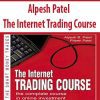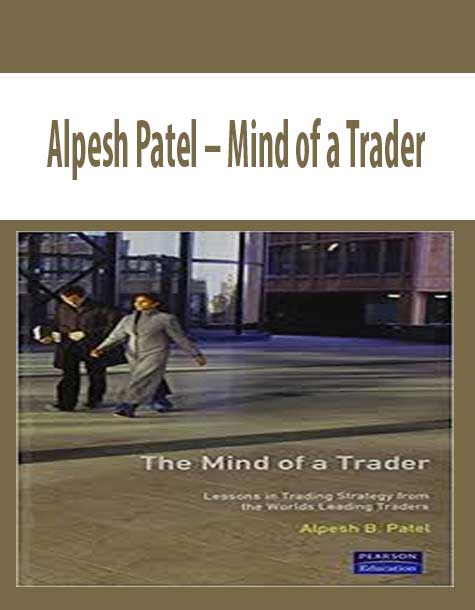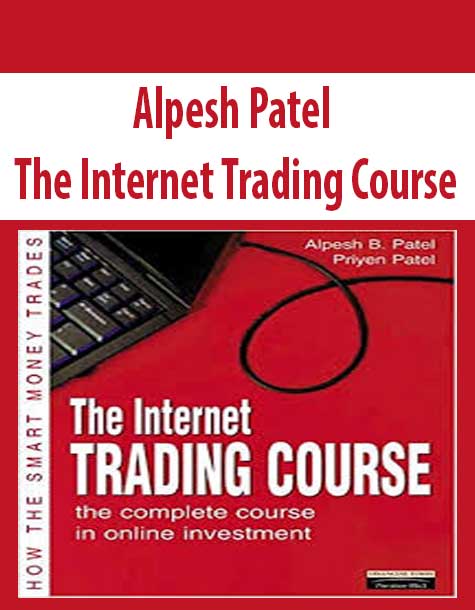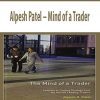Alpesh Patel – Mind of a Trader
$21.00
Alpesh Patel – Mind of a Trader
Product Delivery: You will receive a download link via your order email
Should you have any question, do not hesitate to contact us: [email protected]
ALPESH PATEL – MIND OF A TRADER
The Mind of a Trader: The Most Profitable Trading Tool of All
By Alpesh B. Patel
“You made how much?” I screamed down the phone to the calm voice on the other side of the Atlantic. Tapping away at my calculator, I continued in disbelief, “but that means you earned for Salomon Brothers an average of $250,000 each and every single trading day for eight years!” I resisted the urge to faint, or swear.
I had spoken to many successful traders, but the conversation with Bill Lipschutz, with whom I had had the above conversation, former global head of foreign exchange and managing director at Salomon Brothers, stuck in my mind for the size of his trading successes.
This was my point of arrival, after having spoken and interviewed, even cross-examined and interrogated, the world’s leading traders. The original quest was to find what, if anything, they had in common despite their differences. I did not want the trite and over-used “cut your losses short, set stop-losses, etc., etc.” type of insight. Traders know to cut their losses short, they want to know they are cutting it short and not cutting a potential profit short. Too often the trite rule has missed the real difficult issue.
Nor did I want advice which only the professional trader could use or understand. I wanted to discover something for professional and private traders alike. I wanted to rip out and hold in my hand for close inspection the very heart of trading success.
Any conclusions would be irresistibly and irrefutably strong (as well as hopefully being insightful and original ) because it would relate to trading itself, not just one product, or technique or tool or country. I was not disappointed.
The common element that linked them all, and separated them from their less successful colleagues was their frame of mind; their attitudes to trading, to losses, to open positions, to profits, to success and failure. Indeed, they redefined success and failure itself. Their perspective was unlike that exhibited by any less successful traders. They had a way of viewing trading such that if you were to force them to trade according to a particular system, they would still be more profitable than their colleagues using the same system. They added a value to any potentially profitable trading technique and tool to turn it into a superior profit maker.
A list of the main traits these leading traders exemplified follows:
Opportunity Knocks the Door Down
Since kindergarten each of us is taught to grab opportunities for they do not knock twice. It is precisely that type of advice, which is so useful in other walks of life, but detrimental in trading.
Many traders, armed with their trading plan or strategy, will often hastily and prematurely enter a trade. Their decision is often driven by fear; the fear of the missed opportunity. Their mind will be screaming, “quick get on the trade, you’re going to miss it, so what if all your criteria for entering a trade have not been met? Most of them have, so get on the trade. The big traders wouldn’t hang around.”
The inevitable result is that the trade will not be profitable or as profitable as it would have been had the trader waited for the precise moment to strike.
In trading, the fear of the missed opportunity leads to many avoidable losses. And the game of trading is as much about avoiding losses as about capturing profits. The leading traders have a different perspective on opportunity. Counter-intuitively they know opportunity knocks once, twice and then kicks the door down. They know that if this trade does not feel absolutely perfect, there will be another one along in a short while. That knowledge alleviates and over-rides any fear. That knowledge is the key to unlocking greater profits by waiting for all the trade entry criteria to be met and not cutting corners.
Bill Lipschutz summed it up when he said, “Out of 250 trades in a year, it comes down to five, three of those will be wrong and you will lose a fortune and two will be right and you will make a fortune; for the other 245 trades-you should have been sitting on your hands.”
Great Traders Tend to be Risk Averse
There is a general perception, once again more propagated by life and not trading experiences, that one needs to risk a lot to profit a lot. Every one of the traders I interviewed stated unequivocally that they were risk-averse. As Bernard Oppetit, global head of equity derivatives at Banque Paribas put it, “you do not need to risk a lot to profit a lot.” Jon Najarian, CBOE director and the chairman of Mercury Trading put it similarly, “making money today is not more important than being able to come back tomorrow.”
Pat Arbor, chairman of the Chicago Board of Trade, warned against going for the “home-run.” His trading philosophy is based on “una fagiola;” one bean, at a time into the bag. As one of the most experienced and successful traders on CBOT, he insists trying to put lots of “beans into the bag” at once will result in most not going in. He counsels that the steady approach will result in far more profits in the longer run.
The message is to wait, and wait for a high probability trade in the knowledge that they do exist and can lead to as great a profit as more risky trades. Moreover the danger of riskier trades is not only a loss, but also such a loss that you have no funds left.
Luck: Stacking the Odds
Following on from the nature of traders as being risk-averse, they have a knack for stacking the odds. As Lipchutz puts it, “I happen to believe that by far the biggest component of trading success is luck, it’s not the rolling the dice type of luck, but stacking the odds.” These top traders practice their risk aversion by ensuring the odds of a successful outcome are heavily stacked in their favor.
This is not only done by ample research and planning, but also recognizing that when they are in a good trade to “push their luck.” As David Kyte, chairman of the Kyte Group and the largest local on LIFFE put it, “you do not step in the way of a train that’s going at full steam.” Najarian and Kyte both said, “You make your own luck in this game” meaning that you stack the odds of making a profitable trade by planning and waiting until all your trade entry criteria are satisfied, if then the trade does prove to be as lucrative as it promised you “push your luck” by perhaps adding to the position and riding it for all it is worth.
The Emotional Problem
Trader’s attitude to their potential and existing positions is often a great determinant of success. As every trader knows, the moment a trade is executed, everything is different. That is the point at which it becomes real, no longer digits on a screen and numbers in an account. Now expectation is joined by anticipation. The brain is joined by the heart. Reason is joined by emotion. You exchange detachment for attachment.
When you have an open position and you are looking to close it, you will either have a profit or a loss. The emotions relating to each are quite different. For instance, when sitting on a loss many traders experience hope that the position will turn around because they fear and deny that it may not. It is for you to recognize these emotions and to discard them. Your judgment has to be based on detached reason relating to your analysis of the company.
How you behave once you have an open position is all important. Without clear thinking you could exit too soon or too late. Your key concern with an open position is timing your exit. Of course there are times when you are deciding whether to add to a position, but generally you are concerned with exit. With an open position, you are concerned with closing the position. In order to do that, an open position requires an open mind.
“The key is to be intellectually honest. You have to think of every day as a clean slate. You’ve got to forget about your loss or how much you paid-you have to treat each day as a completely new day. You have to start everyday with a blank page. Mark to market should be the rule so you start each day afresh. There is no expected profit or loss on the book so you have to start from scratch each morning,” says Oppetit.
Poor Planning Produces Pathetic Performance
Although an SAS motto, the above is equally applicable to trading. The top traders did not trade “by the seat of their pants.” Planning and its benefits was a key aspect to the way they viewed the markets. The top traders plan “what if” scenarios and think about their response to each probable outcome. The main benefits were that with plan in hand or in mind the trader’s confidence is enhanced, fear of loss reduced and that in turn assists clear thinking and removal of hope so ensuring the trader stays focused on his original reason for entering the trade.
Oppetit summed this up well when he said, “whether I get out at a profit or loss does not matter.” Martin Burton, founder and managing director of Monument Derivatives and former director of NatWest Markets was talking about the same thing when he said, “it is not a 90 minute game.” They both know that sticking to their plan is far more important than temporary blips in their profit and loss accounts.
Losses-A Curious View
The top traders were totally at ease with losing. This is not something one expects from those at the top of their profession. Although true in other walks of life, that perfection is to be sought, in trading, perfection is not an option. Paul RT Johnson, vice president at ING Securities and a director at CBOT said bluntly, “You are going to be wrong. You are not perfect.”
The top traders would cut their loss and move on. The issue was not whether the market may turnaround if they hung in there. They cut their loss if it is what they had said they would do in their plan. They would get out at the predetermined level. The discipline of sticking to the plan was primary and the real issue. To say “cut your losses short” missed the whole point and was of no help to anyone. By cutting their loss, they would free up capital to place in more profitable positions elsewhere, and free up mental energy to focus on new opportunities. Arbor summed it up by saying, “your first loss is your best loss.”
Conclusion
It is not possible to do justice to the wisdom and accumulated experiences of the world’s leading traders in a short article. However, I have tried to convey how their minds work in a way that apparently runs against common intuition. These differing perspectives ensure that with the same tools and products everyone has to trade with, they make far more in profits because their minds are different.
Get Alpesh Patel – Mind of a Trader
Alpesh Patel, Mind of a Trader, Download Mind of a Trader, Free Mind of a Trader, Mind of a Trader Torrent, Mind of a Trader Review, Mind of a Trader Groupbuy.
Delivery Method
– After your purchase, you’ll see a View your orders link which goes to the Downloads page. Here, you can download all the files associated with your order.
– Downloads are available once your payment is confirmed, we’ll also send you a download notification email separate from any transaction notification emails you receive from IMC.sale.
– Since it is a digital copy, our suggestion is to download and save it to your hard drive. In case the link is broken for any reason, please contact us and we will resend the new download link.
– If you cannot find the download link, please don’t worry about that. We will update and notify you as soon as possible at 8:00 AM – 8:00 PM (UTC+8).
Thank You For Shopping With Us!
Be the first to review “Alpesh Patel – Mind of a Trader” Cancel reply
Related Products
Forex & Trading
Forex & Trading
Forex & Trading




![[Download Now] FX Pips Predator by Alpesh Patel](https://imc.sale/wp-content/uploads/2022/02/Alpesh-Patel-Indicator-1.jpg)



10 reviews for Alpesh Patel – Mind of a Trader
There are no reviews yet.